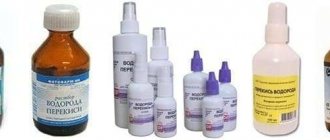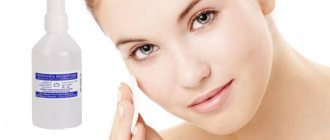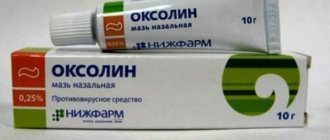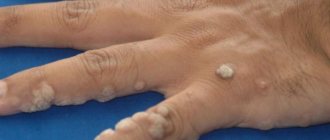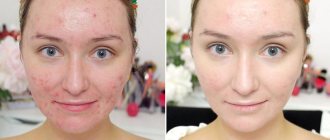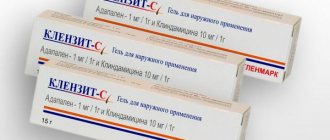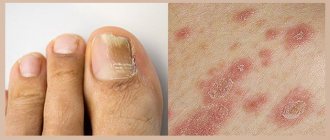Papillomas are growths on the skin that appear as a result of infection with papillomavirus. In 90% of cases, infection occurs when the immune system is weakened due to unprotected sexual intercourse with a carrier. In addition to their unaesthetic appearance, they cause a lot of inconvenience in everyday life.
By carelessness, they can be touched, which will lead to inflammation and bleeding.
Despite the fact that papillomas are benign, under certain conditions they can become malignant.
To avoid such development, it is important to promptly treat the disease. You can get rid of skin tumors not only through surgery, but also through simple home recipes. Some doctors advise using hydrogen peroxide for papillomas; let’s take a closer look at how it affects them.
Mechanism of action
Hydrogen peroxide (peroxide) is an effective antiseptic that has a negative effect on pathogenic bacteria and microorganisms.
In addition to the active substance, it contains sodium benzoate and purified water. Let's figure out how hydrogen peroxide acts on tumors.
Hydrogen peroxide is not able to destroy papillomavirus cells, but it can eliminate its manifestation - growths. Due to its contact with the skin, the substance decomposes into water and oxygen. Oxygen molecules have a detrimental effect on the structures of many neoplasms (in particular, papillomas).
The use of hydrogen peroxide for papillomas shows positive results, due to which it is in particular demand. The main advantage of this treatment is that peroxide is a harmless remedy. However, before use, consultation with a specialist is required.
Professor Neumyvakin about the causes of papillomas
In his works, the professor touched upon the emergence of various diseases and the most effective ways to restore the body. Neumyvakin did not ignore the issue of the development of papillomavirus.
The appearance of papillomas on the human body is associated with exposure to an infectious viral pathogen.
It is transmitted to a healthy person from a sick person due to close contact. There may be maternal transmission to the newborn, sexual intercourse or ordinary household contact.
The virus, having penetrated the human body, encounters a barrier in the form of immune defense. He has to go into a passive form for a while. Activation of the infection will occur as soon as the immune defense weakens. This usually happens when a person suffers from the influence of external and internal unfavorable factors:
- acute course of diseases;
- taking medications, in particular antibiotics;
- hypothermia or overheating;
- overexertion, stress, psychological problems;
- hormonal changes in the body;
- poor nutrition.
A weakened immune system cannot resist infection.
As a result, virus cells actively multiply, and skin formations appear on the body - papillomas, warts or condylomas.
Under certain conditions, papillomas disappear on their own. Occurs with a strong immune system, which recovers quickly. A similar phenomenon can be observed in children. But more often, to remove growths, it is necessary to carry out thorough treatment, which includes external treatment and internal exposure.
Contraindications for use
There are also a number of contraindications to treating papilloma with hydrogen peroxide. Neoplasms localized on the mucous membranes should not be treated with hydrogen peroxide.
Also, absolute contraindications include:
- individual intolerance to the drug;
- diseases of internal organs (in particular, kidneys, liver) of a chronic nature;
- endocrine diseases (thyroid problems);
- pregnancy, lactation period (in the case of internal administration);
- recurrent skin lesions (Dühring's dermatitis).
In order to identify possible individual intolerance, it is enough to conduct a simple allergy test: apply a couple of drops of the solution to the back of the wrist and wait 10-20 minutes. If there is no skin irritation (itching, burning or redness), there are no allergic reactions.
How does hydrogen peroxide work?
Hydrogen peroxide (H2O2) is a chemical antiseptic that is a colorless liquid with a slight, peculiar sour odor. The substance is formed when additional oxygen attaches to a water molecule.
Pharmacological actions of hydrogen peroxide:
- antiseptic, caused by the action of reactive oxygen species released when the product comes into contact with damaged skin. They interact with blood enzymes - catalase and peroxidase, and under the influence of a powerful oxidizing agent, coagulated proteins, pus, and polluting particles are broken down;
- antimicrobial - oxygen molecules released during a chemical reaction negatively affect the growth and reproduction of bacterial flora (especially anaerobes and putrefactive microorganisms); the intensity and duration of action of the product is low;
- disinfectant and deodorizing - when interacting with blood enzymes, hydrogen peroxide forms a large amount of foam, which promotes mechanical cleansing of the wound through oxygen bubbles rising from the bottom to the surface;
- hemostatic - the appearance of a large amount of foam also affects thrombus formation and stopping bleeding from small vessels.
Hydrogen peroxide is used to disinfect wounds and scratches, trophic ulcers in diabetes mellitus, in dentistry (periodontal disease, stomatitis), for dermatological diseases (fungal infections of the skin and mucous membranes, onychomycosis), as an antiseptic for pharyngitis, sinusitis and sore throat.
The essence of treatment
Peroxide has a number of useful properties: it saturates cells with oxygen, cleanses the body of harmful microorganisms, and restores the acid-base balance.
The effectiveness of hydrogen peroxide against tumors has long been proven, but it is prohibited to begin therapy without the permission of the attending physician.
It is used both for external treatment and for oral administration. When used externally, thanks to peroxide, the growth dries out and begins to separate from healthy tissue, and ingestion is aimed at eliminating the virus itself.
To achieve a lasting result, it is important to be patient, because one procedure will not be enough to eliminate the tumor. Papillomas should be removed with hydrogen peroxide only after consultation with your doctor.
Summing up
In general, hydrogen peroxide, although safe, is not effective enough for the treatment of papillomas and warts. You also need to remember that superficial removal of skin growths of the disease does not lead to a cure, since the virus continues to circulate in the blood and with the slightest decrease in the body’s defenses, papillomas will grow again. If, despite treatment, skin growths persistently return, you need to consult a doctor for tests (general blood and urine tests, viral load assessment, immunogram, etc.).
It is important in the treatment of warts not only to remove them mechanically, but also to strengthen the immune system (walking in the fresh air, a nutritious balanced diet, taking vitamins and exercising).
Methods of application
General knowledge (home and folk remedies) allows you to treat papillomas with hydrogen peroxide. This is a common method that is often used when cryotherapy or laser removal is contraindicated. There are several ways to use hydrogen peroxide for papillomas; let’s take a closer look at each method separately.
Traditional way
Many carriers of papillomavirus ask doctors: “Is it possible to remove papillomas with hydrogen peroxide?” This is a fairly popular and safe remedy that shows good results in the treatment of neoplasms. It can be used only if there are no contraindications.
The easiest way is cauterization with a 3% peroxide solution. It is applied in its pure form to the tumor 3 times a day. In order for there to be a therapeutic effect, treatment must be carried out continuously. The number of procedures varies for each person; on average, 6-9 cauterizations are enough.
Compresses
Compresses with hydrogen peroxide for papillomavirus have found wide use in home treatment. To carry them out, in addition to the product, you will need a cotton swab and cling film. The method for preparing a compress is as follows: a cotton swab is moistened with peroxide and applied to the growth, wrapped in cling film. This compress should be kept for about 1-2 hours, after which it is replaced with a new compress. The duration of therapy takes no more than 4 days.
Recipe with oak bark
Oak bark and hydrogen peroxide are often used against papillomas. This method is more effective compared to conventional peroxide-based compresses. The method for preparing oak bark infusion is simple: pour 100 ml of boiling water over the oak bark and leave to infuse for 24 hours in a dark, dry place, protected from sunlight. After a day, the water is drained, and 1 tablespoon of hydrogen peroxide is added to the remaining mixture. The resulting product is stored in the refrigerator.
Apply the product to the affected areas 3 times a day, wrapping it with cling film and a warm cloth on top. The duration of therapy is 25 minutes. When washing off the mixture, it is recommended to use milk at room temperature rather than water. The total course of treatment should not exceed 21 days.
If the growths remain in place, you should consult a doctor.
Ingestion
You can get rid of papillomas not only by external methods. Method of Academician I.P. Neumyvakina involves taking the solution orally. In his opinion, hydrogen peroxide has restorative properties; the product can normalize disturbed processes in the body and eliminate a number of diseases and infections, including papillomavirus.
By ingesting it, it is possible to destroy pathogens and bacteria in the blood. Hydrogen peroxide increases the body's protective functions and helps thin the blood. The duration of therapy with peroxide takes 10 days.
The treatment regimen is as follows:
- the first day. Dissolve 1 drop of hydrogen peroxide in 50 ml of boiled water. The resulting product is consumed in portions 3 times a day during meals;
- second day. Dissolve 2 drops of hydrogen peroxide in 50 ml of boiled water. The method of use is similar. With each subsequent day, the amount of peroxide increases by 1 drop.
If after 10 days there is no improvement and the papilloma remains in place, treatment should be stopped. Whether hydrogen peroxide treats HPV has been a pressing question for many years. Numerous studies confirm the high effectiveness of the product.
In addition to peroxide, Academician I.P. Neumyvakin advises another method for eliminating papillomavirus - taking a soda solution. With its help, the acid-base balance is restored. The academician recommends drinking soda solution 2-3 times a day 15 minutes before meals. To prepare the solution, take 1 teaspoon of baking soda per 250 ml of boiled water. The duration of such treatment is 14-21 days, but, as in the case of hydrogen peroxide, consultation with a specialist is first required.
Why do papillomas appear?
Two thirds of the world's population experience papillomas and warts. These benign neoplasms are viral in nature and appear under the influence of the human papillomavirus (HPV), which more than 70% of the population has.
Activation of the virus occurs against the background of decreased immunity after illness, vitamin deficiency, and also due to prolonged physical and emotional fatigue.
In most cases, the formation of a growth does not cause any discomfort or harm to health. However, these growths can appear anywhere, often causing discomfort when wearing tight-fitting clothing. The neoplasm has a soft structure and is easy to injure. Since it feeds on small capillaries, pain and bleeding may occur during injury, so if there are no contraindications and the patient feels discomfort, it is recommended to remove papillomas and warts.
Skin tumors themselves are not dangerous, just like the human papillomavirus. However, in very rare cases, a benign neoplasm can degenerate into a malignant one under the influence of certain factors.
Possible harm
Hydrogen peroxide should not be used for papillomas that are located on mucous membranes and in intimate places. This can cause severe discomfort. Also, it is important to strictly follow the instructions for the methods described above, since inappropriate use can lead to irritation and redness of the skin.
There are cases when, a few weeks after removal of the papilloma, a new growth forms at this site. With this development of events, it is important to consult a doctor in a timely manner to find another method of treatment.
Advantages of the product
The drug is safe and can be used externally by pregnant women and nursing mothers
Compared to drugs intended to treat warts, hydrogen peroxide has a number of advantages. They are as follows:
- Low price. In terms of cost, peroxide is the cheapest solution for removing growths.
- Possibility of use during pregnancy and lactation. If we are talking about external use, then, unlike most specialized drugs for warts, hydrogen peroxide is allowed to be used by pregnant women at all stages and lactating women.
- Diabetics can also treat warts with hydrogen peroxide without any worries.
- Availability. Hydrogen peroxide can be purchased at any pharmacy.
Forecast
There should be a comprehensive approach to the treatment of papillomas, because it is impossible to eliminate the infectious pathogen and get rid of the tumor with only one remedy. To sum up the question: “Is it possible to cauterize papillomas with hydrogen peroxide?”, the answer is unequivocal - it is possible. The main conditions for such treatment are the absence of contraindications and strict adherence to the instructions for use.
The effect after procedures with peroxide can be achieved with regular treatment.
The use of peroxide simultaneously with drug therapy allows achieving stable remission. To avoid relapse, it is worth taking preventive measures. It is important to adhere to proper nutrition, walk in the fresh air and take vitamin and mineral complexes.
If you find an error, please select a piece of text and press Ctrl+Enter. We will definitely fix it, and you will get + to karma
Hello, my name is Anna, I’m 24 years old, 2 years ago I was diagnosed with dysplasia, HPV type 31,39,58 and erosion, I was treated, the erosion was cured with tampons and it didn’t bother me anymore, they did an electrobiopsy, everything is fine too. And now, 2 years later (and I was checked every six months and everything was normal, the only red spot after the electrobiopsy, how many times I checked and took tests, everything was fine, just like a scar), the last time I went to get checked and was diagnosed again HPV 6 (7.3 lg), 44 (2.5 lg), 56 (2.9 lg), and a small spot on the uterus, dysplasia is suspected again, all other tests are normal, chlamydia, no trichomanas, blood, urine are excellent, no sexually transmitted diseases, The only thing is that the flora is disturbed (there is no thrush), and the leukocytes in the cultures are elevated, she ordered me to put Laferobion suppositories at night, and to come and take baths, with a tampon of Viferon ointment, every other day for 10 days, injections (6 injections) of allokin-alpha, and she said that 95% of women are cured of HPV, as far as I know, HPV cannot be treated, the virus is simply dulled so that it does not multiply with consequences. For me, all these baths and allokin are very expensive, I am a student and an orphan and I don’t have that kind of money. Please tell me how effective this treatment is? and is there a cheaper way to treat these types of HPV?
Woman.ru experts
Find out the opinion of an expert on your topic
Tropina Natalya Vladimirovna
Psychotherapist. Specialist from the site b17.ru
Samorukov Konstantin
Psychologist, Consultant. Specialist from the site b17.ru
Slobodyanik Marina Valerievna
Psychologist. Specialist from the site b17.ru
Natalya Maratovna Rozhnova
Psychologist. Specialist from the site b17.ru
Wrzecinska Eva
Psychologist. Specialist from the site b17.ru
Albert Rustemovich Chersheev
Psychologist, Clinical psychologist. Specialist from the site b17.ru
Spiridonova Nadezhda Viktorovna
Psychologist. Specialist from the site b17.ru
Svetlana Chernyshova
Psychologist, Consultant. Specialist from the site b17.ru
Sheludyakov Sergey
Psychologist, Clinical psychologist. Specialist from the site b17.ru
